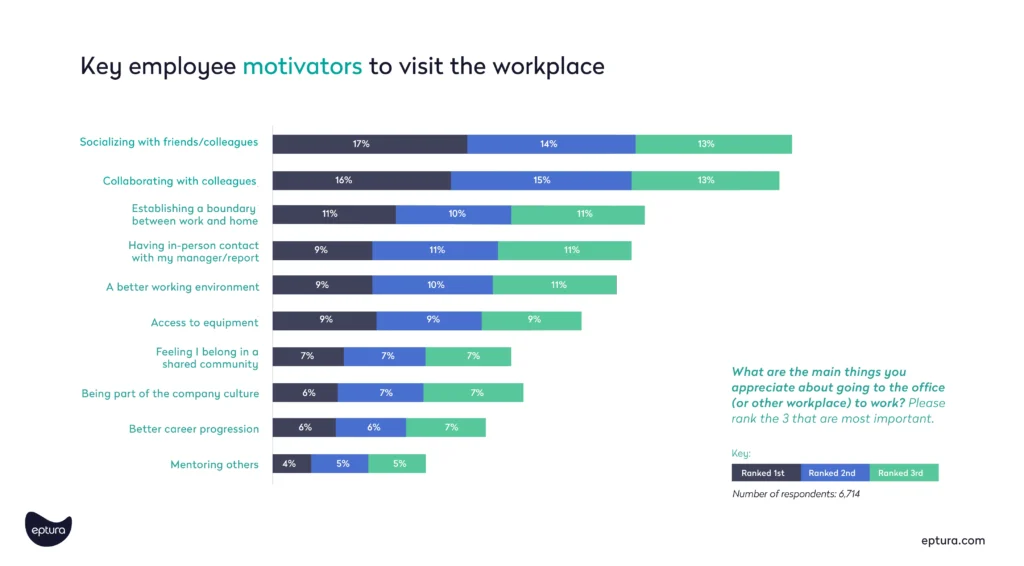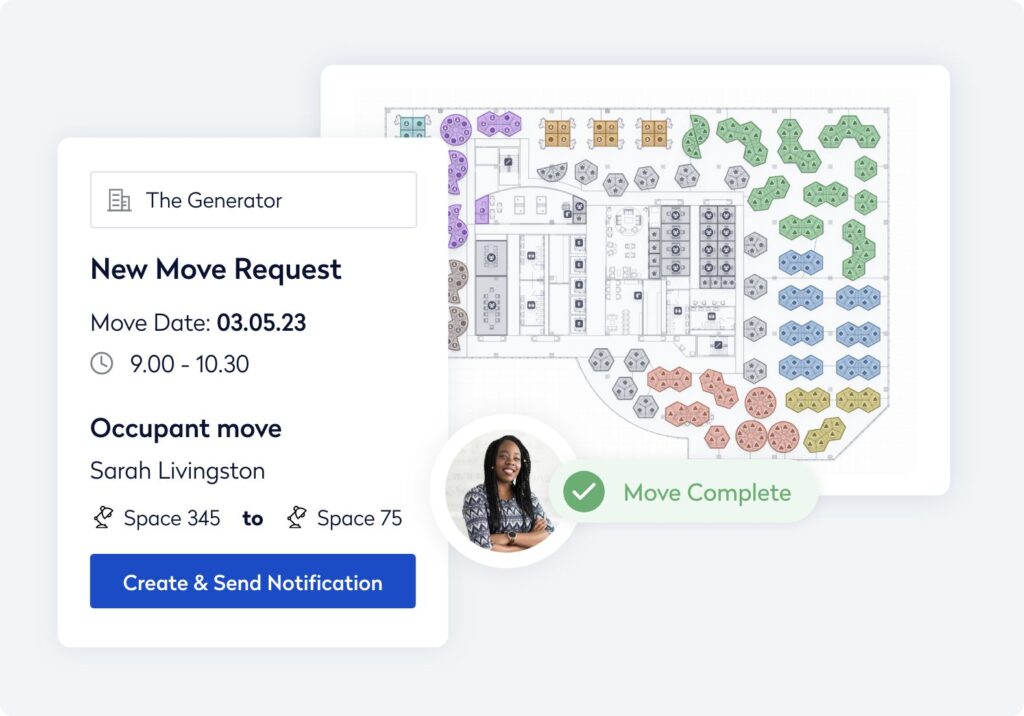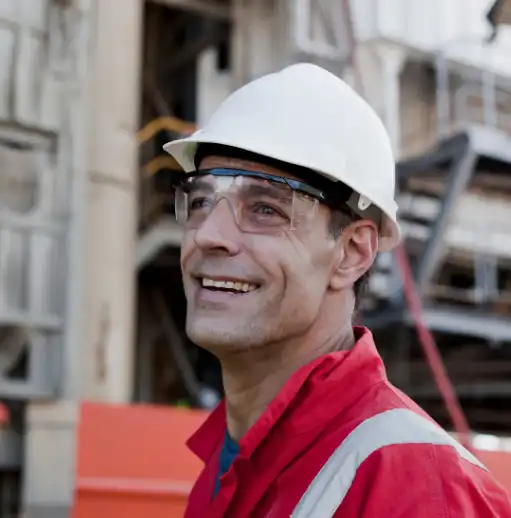
While workspace management wasn’t always a priority for mid-sized organizations, it is today. The pandemic accelerated digital transformation and introduced totally new processes and technologies focused on remote, at-home work.
Since then, organizations with less than 2,000 employees have discovered the need for balance in where they work. Between 2022 and 2023, the Americas saw an increase in desk bookings by 84% — and an increase in meeting room bookings by 48%, according to our Q2 Workplace Index report.
As employers strive to ‘earn the commute,’ companies that don’t have sizable facility management teams are feeling the squeeze. Mid-market organizations are juggling competing priorities across business functions, working out the bottom line of where, when, and how to optimize available space and adjust to new operational requirements.
People want to connect and learn from others in an office or co-working space, but not five days a week. In 2023, 69% of mid-sized firms have employees working outside the office part of the workweek. Hybrid work is prominent, and its effect on business is unavoidable.
Because of these facts, more and more companies are adopting shared space models, which may be a completely new experience. And so, space planning, workspace utilization, and the ability to share and book desks and meeting rooms are a priority.
Workplace technology can help with floorplan mapping, office moves, and space reservations. To help meet today’s needs of mid-sized organizations, we’ve launched Eptura Workplace Core and Asset Core.
Eptura Core is scalable and tailored to grow with business needs. Designed for easy implementation and quick results, the software is user-friendly and intuitive, so it doesn’t require dedicated staff to operate it.
See how Eptura Core and Advanced compare on our plans page.
To get more perspective, we interviewed one of the architects of the Eptura Workplace Core offering, Pam Matula, Director of Workplace Product. Pam was a facilities manager for 14 years for Hilcorp Energy Company in Houston – and a former customer of Eptura’s legacy product, iOffice. She brought her direct facility management experience to Eptura.
Tell us about your background in workplace and facilities management.
I spent 19 years working in facilities management in a corporate environment, predominantly within oil and gas and a couple of other industries. I was a customer of iOffice and used the product for 6 to 7 years.
Of course, today iOffice is now Eptura. But seven years ago, when I transitioned to the other side of the fence, I initially began working for iOffice. I started in account management, did a short stint in project management, and have been in the product management group for about three years now.
You mentioned oil and gas. What was it like being a facilities manager for an oil and gas company?
Hilcorp Energy Company is a privately held oil and gas company. At the time, there were about 500 employees in the corporate office and about 1200 across the organization. I worked within the corporate environment managing day-to-day operations, not managing physical plants or facilities related to field operations.
I also did work for many regional field offices on construction jobs and refurbishment of their facilities. “We need somebody to fix the roof in the regional office,” that kind of thing. But as we expanded our operations, not just in Texas but in multiple states, there were more and more field offices to support.
Did you see a big range of work types that you had to deal with?
I was very much a Jack of all trades. Like most companies leasing space, we didn’t maintain maintenance crews. We outsourced that work. We had relationships with electricians and building management maintenance teams – and used local tradespeople for field offices. There was a lot of work to maintain the facilities and keep them running smoothly.
Buildings need to last decades, so it was a lot of vendor management and relationship management, working as a liaison with folks in the field offices to get work executed. Lots of field visits and a lot of traveling. Everywhere from the swamps in Louisiana up to Alaska. We had many facilities across multiple states.
So, you’ve had real experience in the field. You know the pains of a facility manager. What do you think remains the same today?
I think that the need to understand how space is allocated and utilized by people and assets. That hasn’t changed. Regardless of what type of model you may be adapting, space planners still need to know: how much space do I have? Where is it? How many people are we accommodating in that space? What assets do I have in that space? How am I accounting for those things and the different specialized functions?
A space planner versus an asset manager versus someone taking care of a mail room, reception, or security function. Facilities in a built environment have a very broad application. There are individuals who are very niche and individuals who work more broadly.
Plus, the need to have good data to make informed business decisions and recommendations to leadership has stayed the same.
![[Space Viewer - Space Types] Easily configure your workplace and allocate resources like desks, meeting rooms, and shared spaces to create a more modern and agile workplace.](https://eptura.com/wp-content/uploads/2023/09/CORE-space-optimization-1024x728.webp)
What do you think has changed and evolved in workspace management?
We’ve seen a significant shift from the traditional 1:1 seating environment to shared space models. Not to say that we didn’t have open plans with unassigned seating previously.
But the rapid adoption of a more hybrid environment post-COVID has just been astronomical. I’ve seen statistics that up to 90% of customers use some variation of a hybrid work model or have one in play within their environments. So, it’s constantly changing, constantly shifting.
Every customer approaches this in a slightly different way. It has been a moving target over the last few years. We used to sit in our quarterly customer advisory board meetings, and every time we met with this key set of customers, the approach would change from quarter to quarter.
They’d have a very specific plan and how they planned to execute it. And then it would not see the adoption they expected. So, it’s a constant reexamination of the data and the feedback loop they’re getting from their employees.
I have seen many customers become less prescriptive about what that approach will be and more flexible. I think they’ve just had to adapt to their workforce.
Another thing I’ve seen that’s really changed is during the purchasing process. There’s been less emphasis on the space planner or the facility manager only, and more focus on the employee experience because of the impact of what we’ve all been through the past few years.
So, there’s been a shift toward team-centric use to being able to book zones or neighborhoods with a focus on collaborative spaces.
There have been a lot of reconfigurations in the built environment through renovation or reallocation to entice employees to come in. Our customers are trying to communicate the value of coming into the office to their employees.
Because many people will say they can do focus work at home. I don’t need to come into the office for that. So, the value of being in an office for employees is about collaboration and leveraging collaboration tools, meeting with their fellow coworkers, and the ability to have more whiteboard sessions.
I think no matter how good the tools are in applications, for whiteboarding and collaboration, nothing beats being face-to-face with somebody periodically.
For the commercial real estate industry and space planners, it’s about how we adjust that built environment to attract folks to come in and adopt whatever policy has been laid out regarding how often you’re expected to be in the office.
What are our global customers experiencing right now? What are some of the biggest obstacles they’re facing that are unique in other parts of the world?
Localization is a big one. Making sure that our product is offered in a multitude of languages and that we’ve got good translations so that the individual in Japan feels just as seen as the person in the United States.
The problems don’t change in terms of managing those people, places, and things. I think it’s more about the nuance from a regional basis and into how it’s approached. You need to know how much space you have and how many people are coming in.
It doesn’t change.
Many customers start with a local office, and even though the company might operate globally, they’re starting with our solution in one place and wind up expanding.
I think that’s where our flexibility to configure locations in one country differently from how you might need to do it in another country comes in handy. We refer to it as an operational segregation of data.
Use of that data and the transactions that employees are creating, whether they’re doing a chargeback or they need to allocate to a particular cost center, that kind of separation is inherent to the product.
Security compliance varies across the world. So, offering a security profile accommodates that global perspective of protecting the employees’ personal identifying information and still having the data needed for the business to operate and make those daily decisions.
Are there any use cases that you’ve seen come up that customers are asking for?
They want to understand how space is being used, and they want proactive recommendations about utilization and the end user experience. How they can get a step or two ahead of the end user in their journey within our software so that it’s frictionless. Pave the path for them instead of making them hunt, dig, and work for it. We make it as seamless as possible.
They want ways within the technology to encourage collaboration and office visits. Say, for example, the software recognizes that 60% of your team will be in on a given Wednesday one week, so it could suggest that it’s a good day to go in, even though Wednesday isn’t a typical in-office day for you.
I think that’s exactly where I see the most benefit to the end user, helping them plan their week. As things get more integrated, and the artificial intelligence and pattern recognition kick in, you start to see how you can get a lot tighter with your asset and inventory management for maintaining buildings.
Can we adjust the cooling system so it’s a little warmer on the floor? Can we shut all the lights off? Can we look across two different floors where one has 40 to 50% utilization?
80% of the time, we’re just going to have a floor go dark for six months and consolidate everybody on a single floor. The next time we do a lease renewal, we don’t need that extra 20,000 sq. ft.
What about technology to become smarter and more efficient with maintenance planning?
During COVID when very few of us were in the office, many professionals still had to go into work every day. But in the typical corporate environment, when workspaces were barely utilized, the buildings still needed to be operated.
The HVAC systems had to be maintained. The electrical and plumbing systems had to be maintained. Next to labor, real estate is typically the second most expensive thing on the books for any given company. It’s not inexpensive, so anything that you can do to make the workplace more efficient or help make decisions to optimize it, that’s of great value to our customers.
Any advice on how to use technology for facilities management?
Certainly, in our mid-market sector you see this approach. Many have seen considerable gains in efficiency when you have customers still using spreadsheets and PDF copies of a floor plan. Trying to rebalance your floor plan this way is a manual process.
When they come into a digital system that offers a variety of solutions, not just for space but for move management, for your mail room, your asset inventory, request tickets, and more, the excitement in their voice is palatable when they see their floor plan digitized for the first time.
I’ve sat in on many implementation calls and observed customers and the ease with which they can now manage that data compared to the Excel spreadsheet they’ve been using for years. Everything from managing office temperature requests to quarterly HVAC unit maintenance inspections are possible to schedule and automate the process – and collect data about it.
There are many different disciplines within the facility management world, so having an ecosystem that addresses multiple problems with data that can be shared across the ecosystem is important.
It could be the HR system of record, the calendar system, the building automation system, or the ticketing systems that are culturally entrenched for whatever reason they want to talk to our system. There are security and badging systems, sensor data, and Wi-Fi networks. There is an endless list of systems we integrate with to provide a holistic view of their space.
What is Eptura Core?
The Core pricing tier is a direct response to mid-sized customers. It’s an initial entry point for a medium-sized facility portfolio where they may not be staffed to do some of the niche facility management roles.
They may not have an operations asset manager on staff, so we’re offering them a solution that’s a simpler entry point for workspace and asset needs. Core provides a certain amount of pre-configuration of the application based on our time working with customers and our knowledge of best practices.
It is simple to install and provides a quick time to value. Once the buying decision is made, customers want to move quickly. They’re ready to get started. The goal of the offer is to geta customer up and running rapidly to take advantage of the rich ecosystem.
And what is our Advanced tier?
Some customers may have more complex set-ups, such as deeper integration needs. They may have more complexity to their portfolio that requires a little bit more time with our professional services team than a brand-new entry customer may have. We recognize that difference in some of the buyers that come to the table with us, so we want to make that journey a little bit easier.
Anything else about Eptura Core and Advanced?
It is all continuing to evolve and be improved upon. Know that these offerings are not a fixed point and that we’re always listening to our customers and innovating to make the experience more valuable. From day-to-day product use to reporting and data analysis to run their business, we want to be a partner with our customers.
This offer is intended to be modular, meaning you can get started and add additional things as you need them. And both Core and Advanced work together seamlessly, making the transition smooth as the customer grows and evolves. It still looks and feels the same.
The transition can be made quite smoothly. It’s about opening the doors to additional functionality without changing the essential experience you’ve already learned. Because we understand that it takes time to get your employees to use the software daily.
It takes time to train people.
What is the onboarding process for Eptura Core?
It’s always going to be specific to the customer. We want you to have an easy and intuitive onboarding experience. We want you to understand how your product works and help you get to a place of self-sufficiency.
That’s always been the goal of the professional services engagement – to involve the team and to educate and teach them. We want you to take ownership of the product, but we’re certainly here if you need help.
Learn more about what’s included in Eptura Workplace Core and Advanced.
Pam Matula
Pam is the Director of Workplace Product at Eptura. She has worked within the facility management industry for over 20 years and with iOffice in account management, project management, and product management. Pam has certifications from the University of Houston in construction and project management – and is an IFMA Facility Management Professional. She resides in Houston, Texas.






